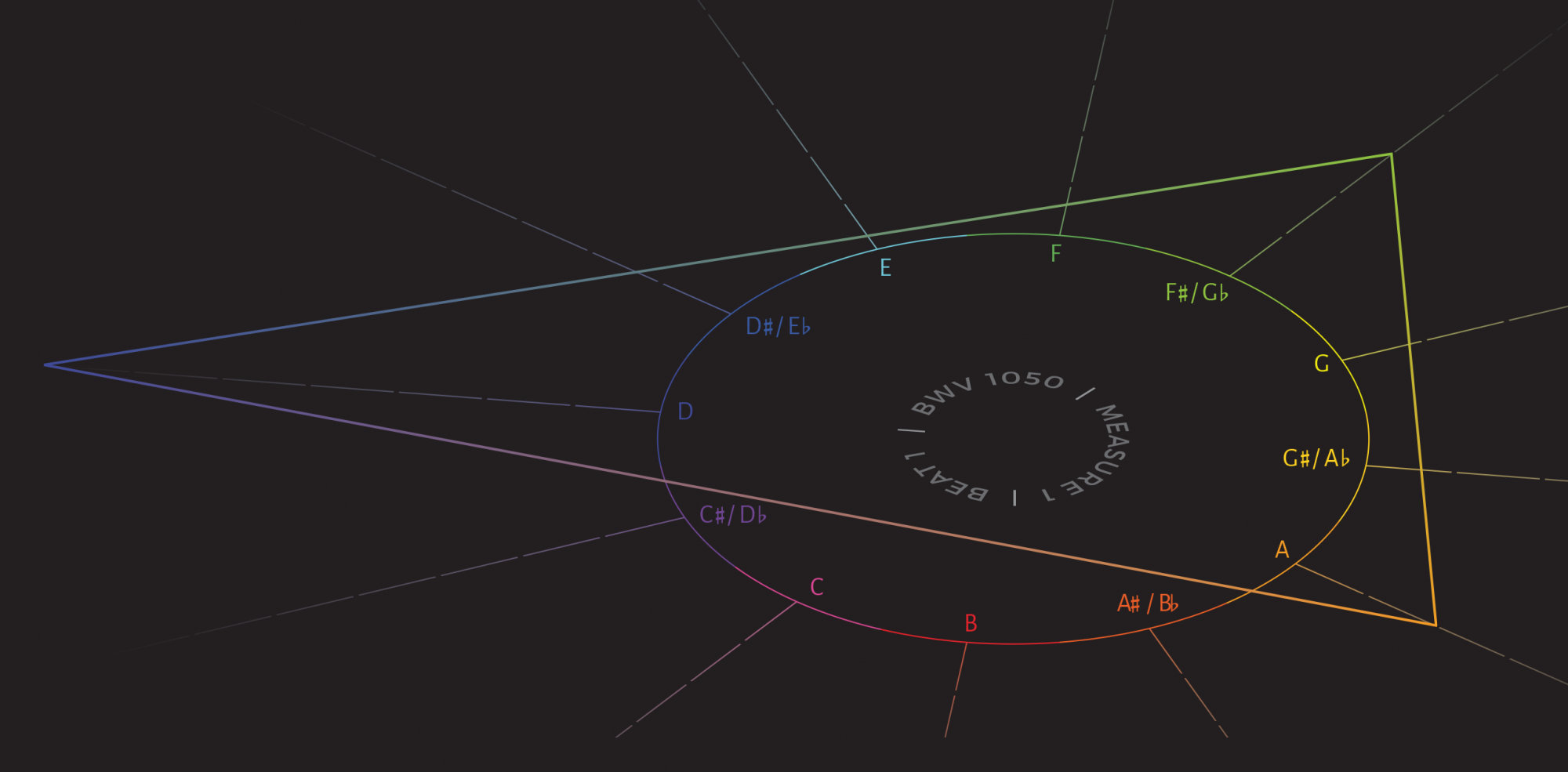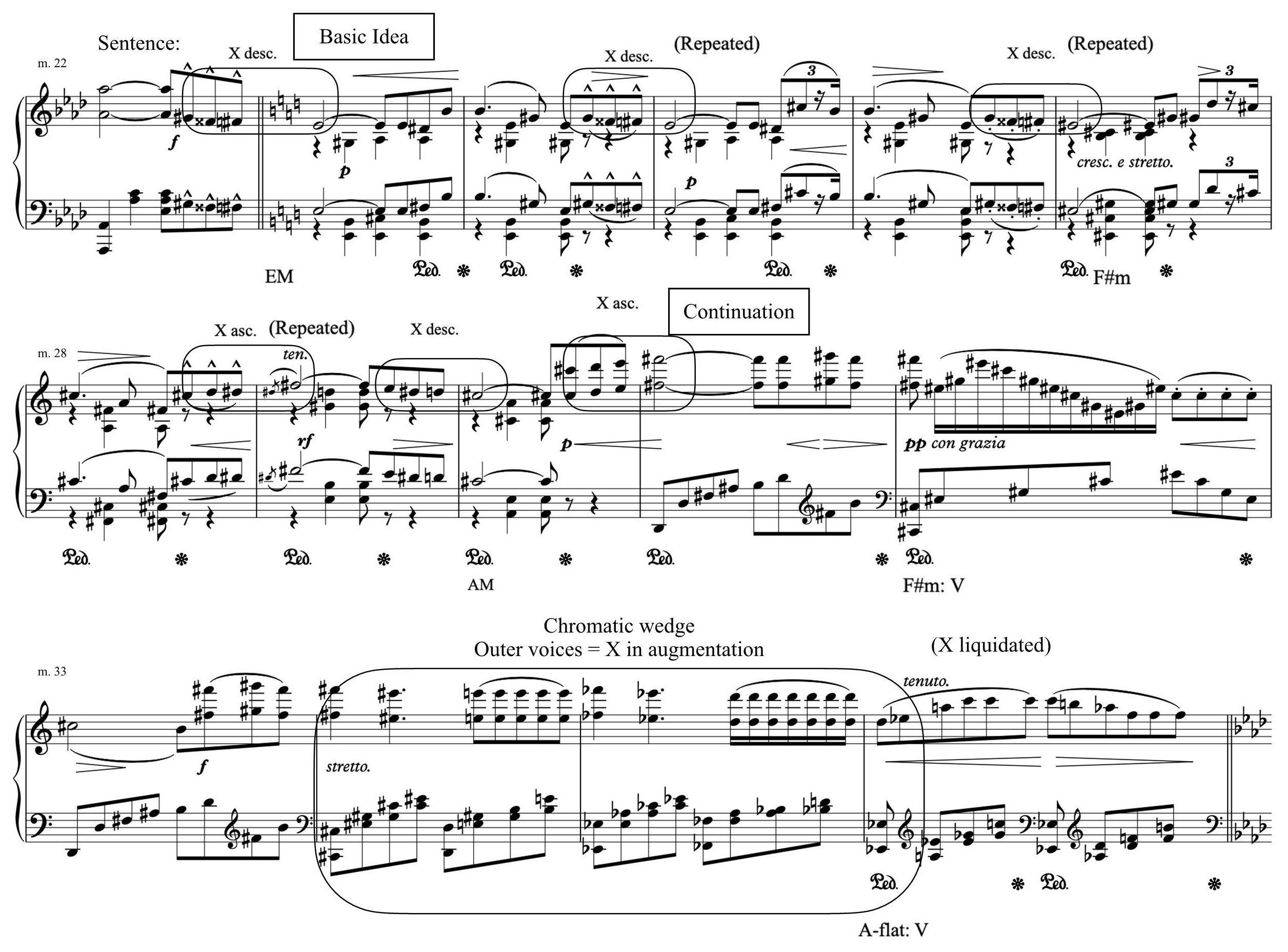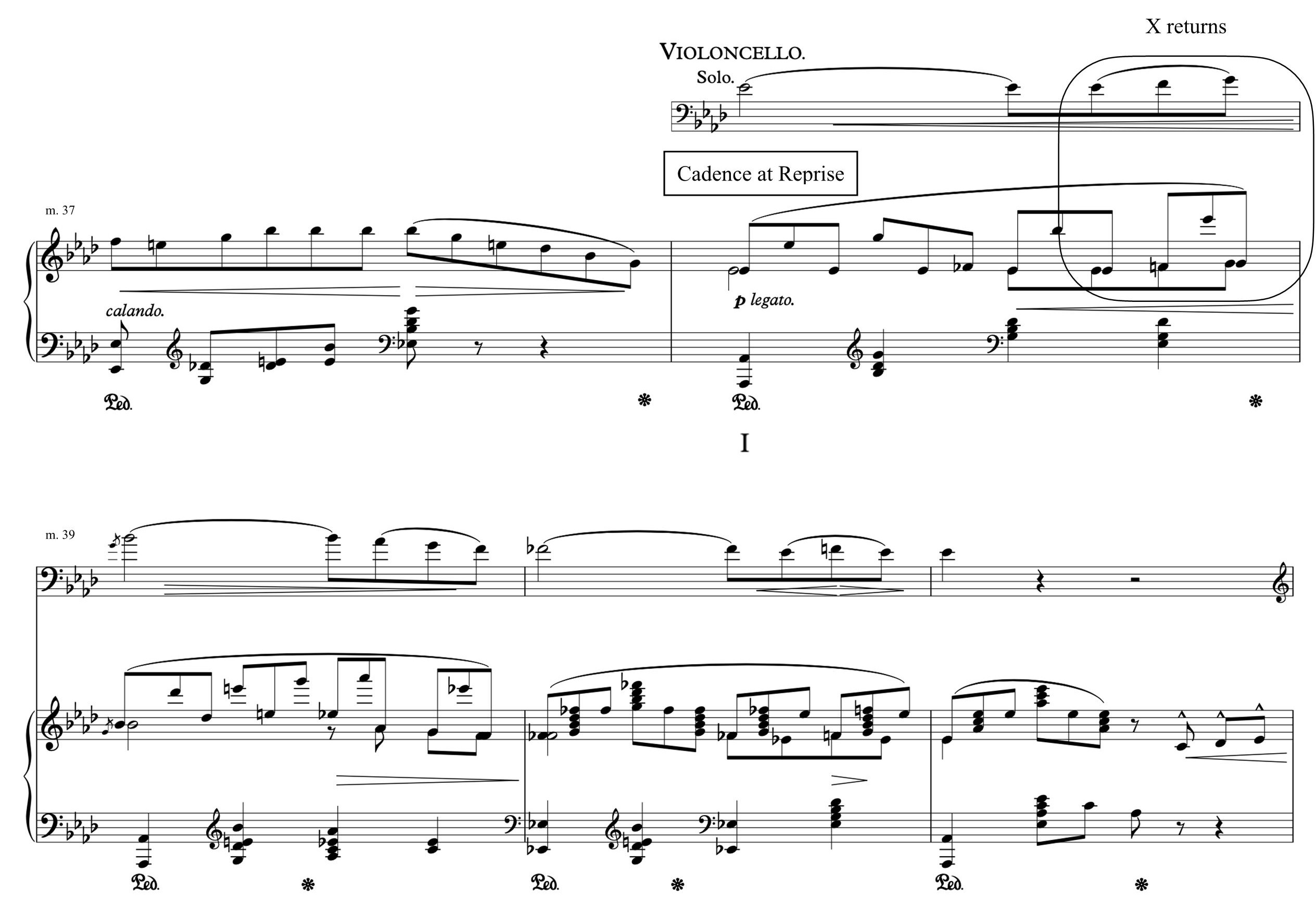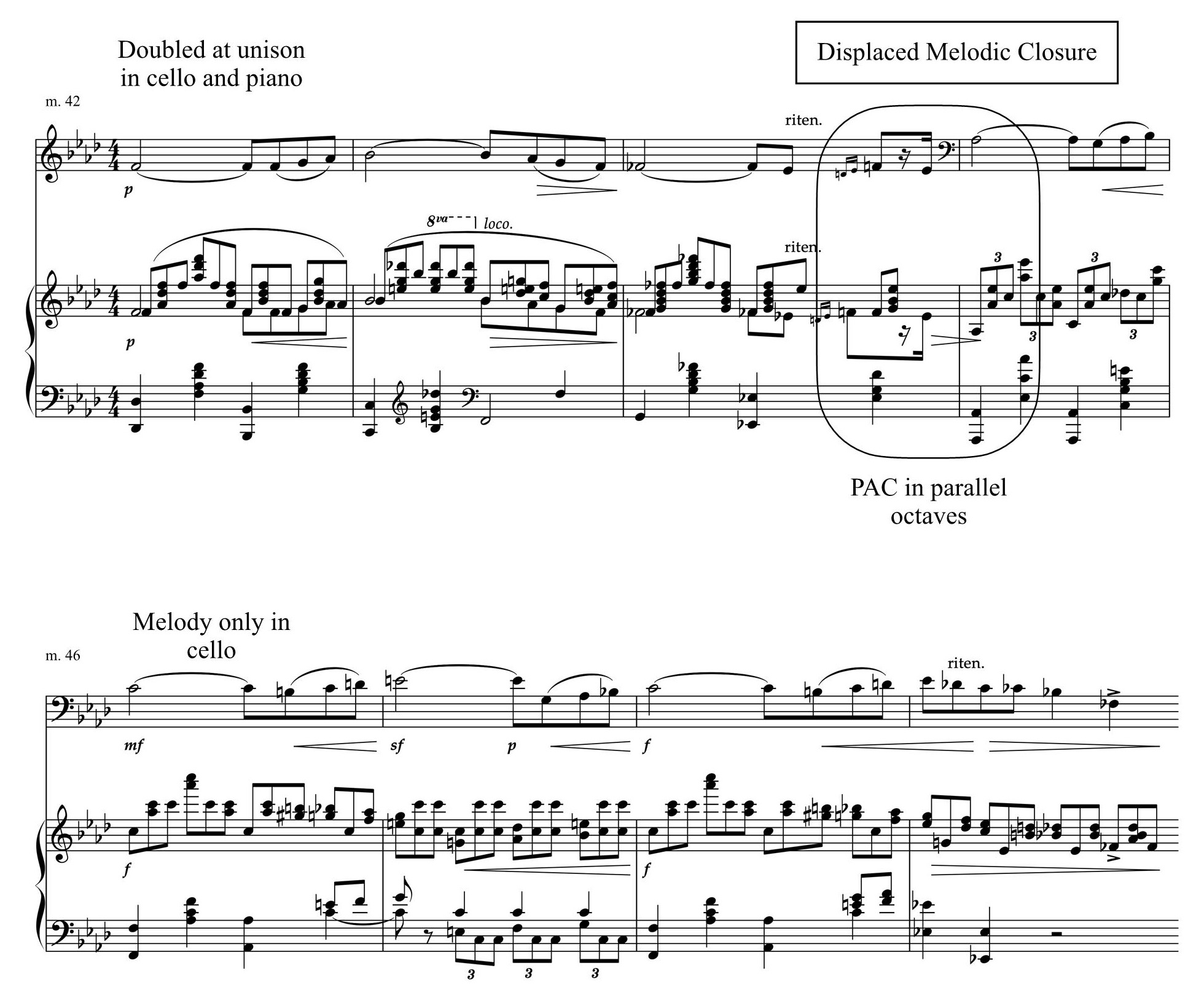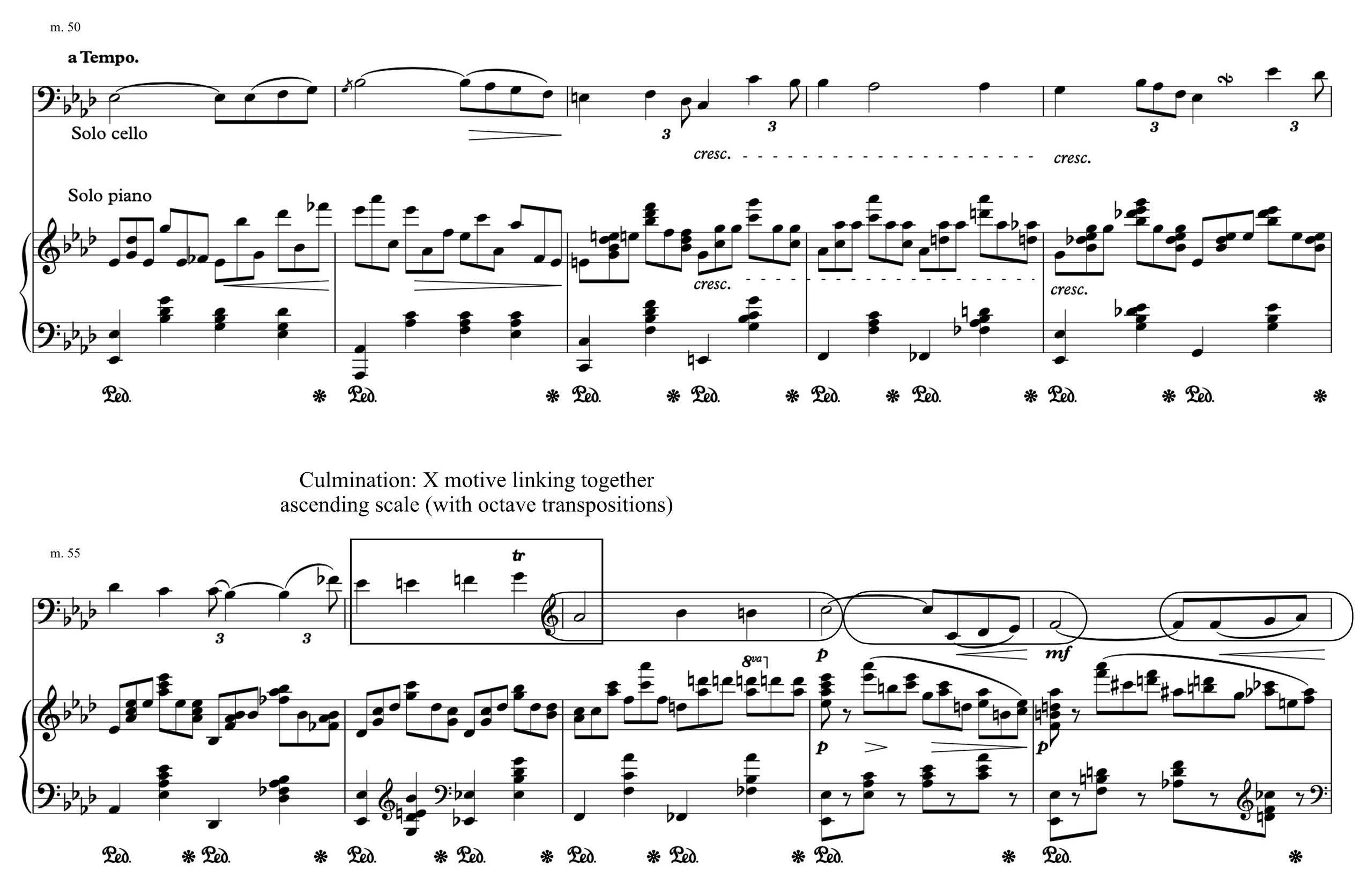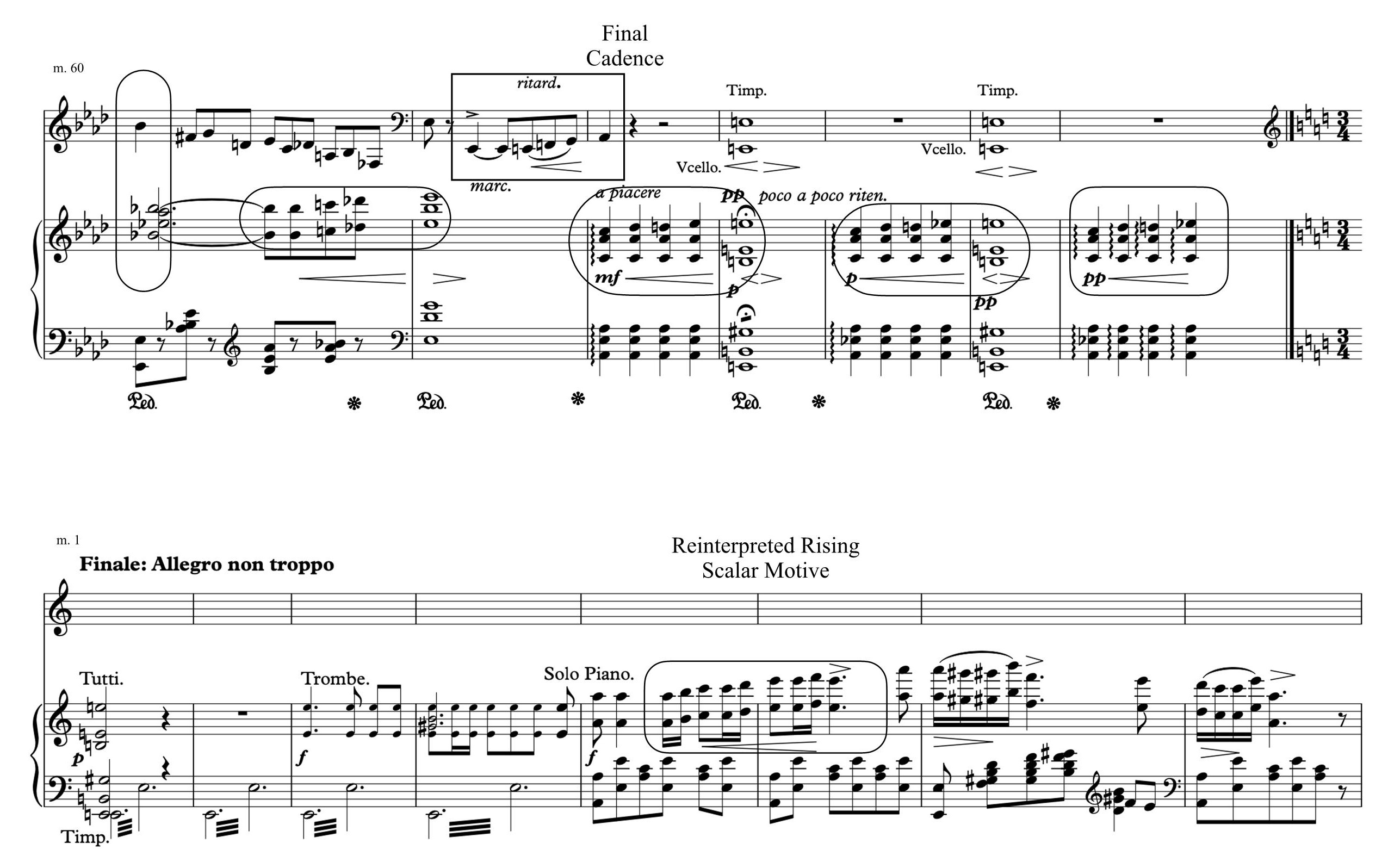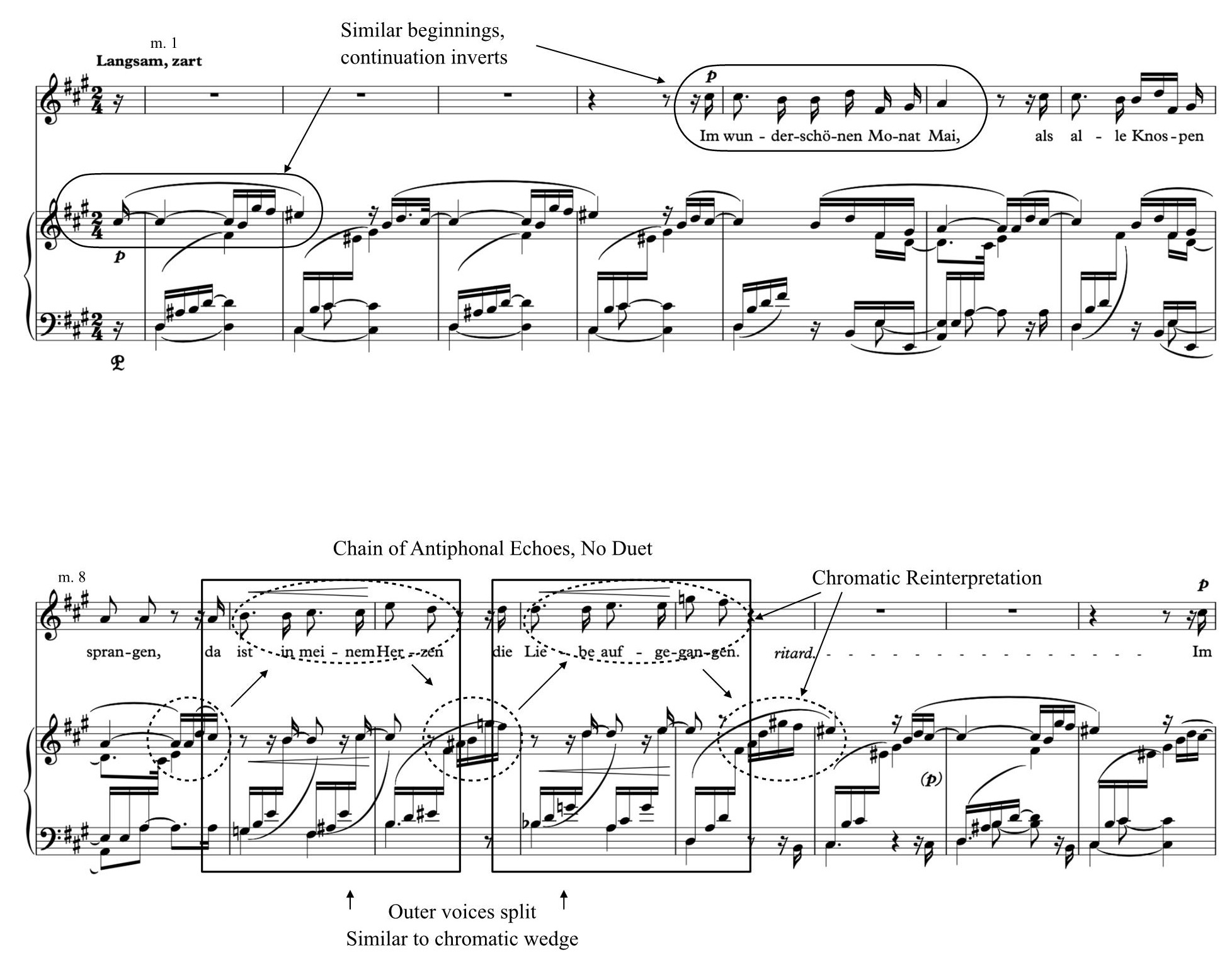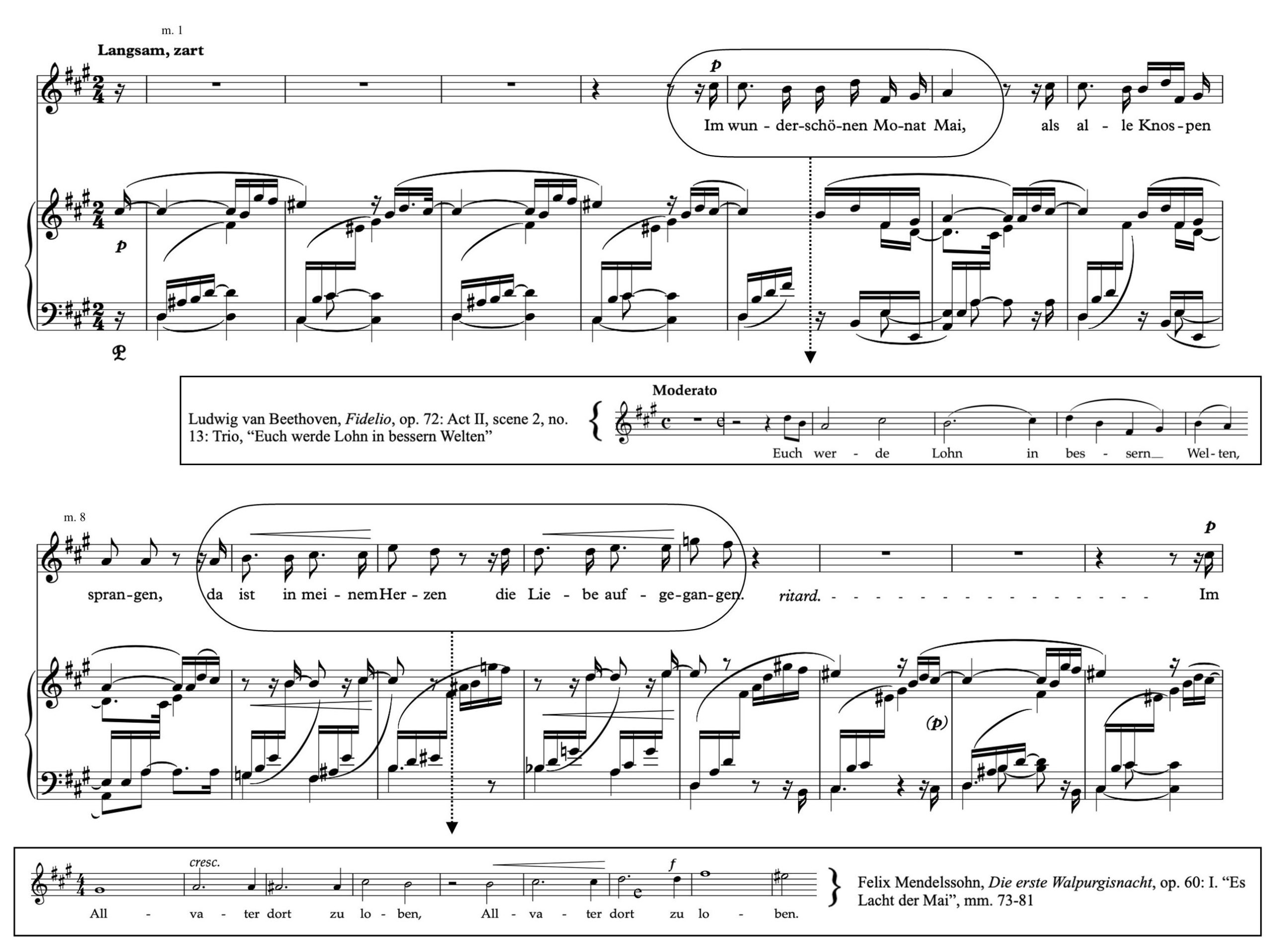David Keep
Abstract
The allusion in Robert Schumann’s “Im wunderschönen Monat Mai” to Clara Schumann’s Piano Concerto, op. 7 has been little discussed. Given Robert’s familiarity with the concerto, the allusion may be understood as a hermeneutic key for the song. The slow movement features a duet between solo piano and cello in its reprise of the main theme, but the song only recalls a tonally distant fragment from the digression. The allusion draws upon music of anticipation rather than fulfillment. Furthermore, it stands as a contradictory symbol of presence and absence, substituting for recollections of the past found in the Prologue of Heine’s Lyrisches Intermezzo. The song’s intertextual dimensions function in tandem with tonal pairing to engender a sense of motion characteristic of the Romantic fragment. In one of his most quintessential works, Robert’s poetic speaker is dominated by thoughts of Clara’s music, not “original” music of his own.
Keywords and phrases: Intertextuality, Robert Schumann, Clara Schumann, Heinrich Heine, Gender, Genre, Fragment, Interiority
Introduction
The voluminous literature on Schumann’s Dichterliebe has neglected the interpretive potential of a remarkably little-discussed intertextual allusion in the cycle’s opening song.1 As shown in Example 1, the piano solo that occurs three times in Robert’s song closely resembles a passage from the second movement of Clara Schumann’s Piano Concerto in A minor, op. 7.
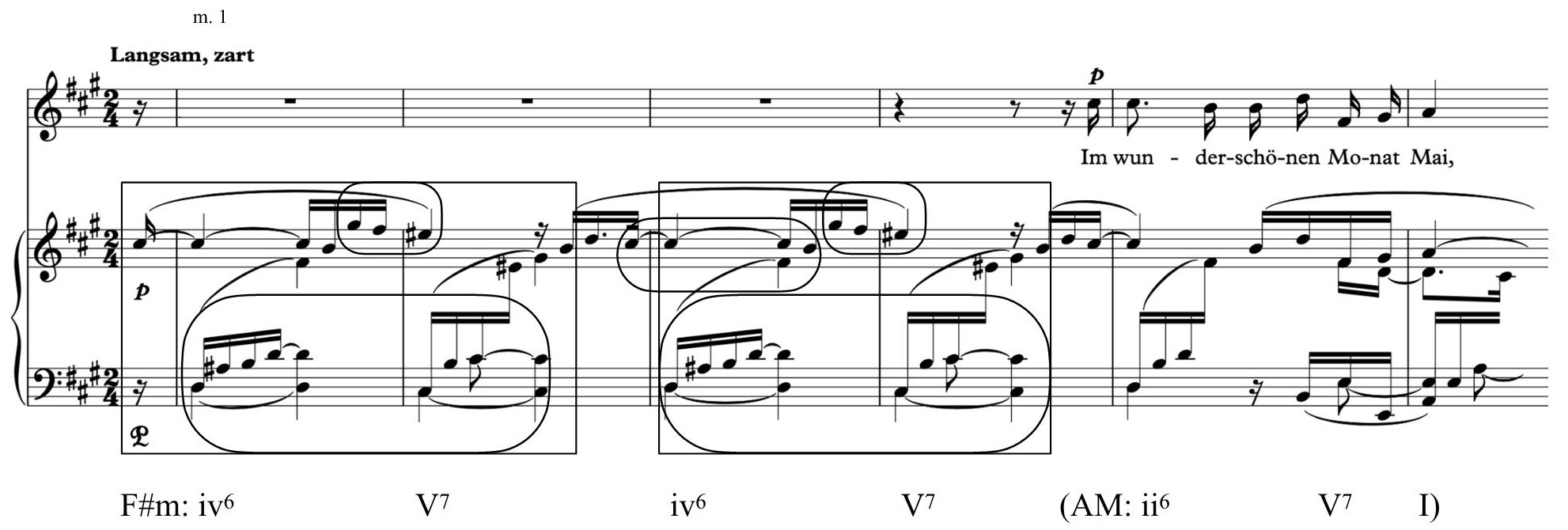
Example 1: Robert’s Allusion to Clara’s Concerto
Both excerpts approach the dominant of F$$\sharp$$ minor twice via the bass line D-C$$\sharp$$, with similar rising left-hand arpeggios that outline predominant and dominant harmonies (note especially the comparable resolutions of nonharmonic tones, such as A$$\sharp$$-B). The melodic treble is progressively embellished in Clara’s passage, growing in dynamics and thickening in texture. Robert pares down the counterpoint, statically preserving the outer voices. In what appears to be the only published discussion of this allusion, R. Larry Todd (2002) observes that “Robert seems to have found a passage that later provided inspiration for his song cycle Dichterliebe,” concluding that the excerpt from the concerto “looks ahead with remarkable exactitude to ‘Im wunderschönen Monat Mai’” (773). Though Todd ends the comparison with this statement, much more can be said about this striking resonance. To begin, this article briefly considers aspects of historical context that support this allusion’s viability. Taking the allusion to Clara’s concerto as a hermeneutic key for Robert’s song, the following analysis will build on Todd’s observation by comparing both works in detail. An analytical vignette of the Romanze slow movement precedes an interpretation of “Im wunderschönen Monat Mai,” which focuses on the ways the song both preserves and negates various elements of its allusive source. Notably, the ternary-form Romanze’s first two sections showcase the piano soloist playing without orchestra, only to be joined by a solo cello in the reprise’s rapturous duet. I interpret the song as a response to this trajectory via the allusion, as it denies the climactic duet moments of the Romanze and repeatedly emphasizes the speaker’s isolation. Through this comparative analysis, the allusion takes on meaning as a contradictory symbol of presence and absence and as a substitute for aspects of the omitted Prologue from Heine’s Lyrisches Intermezzo, with its visions and recollections of the past. Furthermore, by relating the allusion to other references in the song to works of Beethoven and Mendelssohn observed by Christopher Reynolds (2003), I argue that the song’s intertextual dimensions function in tandem with its distinctive tonal pairing to engender a sense of motion characteristic of the Romantic fragment. Through the song’s gestures away from itself, Clara’s voice resounds in this enigmatic work.
Viewing the song through the lens of the concerto is not a strategy that will supplant the contributions of the substantial literature on Dichterliebe, but it will instead supplement by bringing two works linked via allusion into closer relation with one another, opening further hermeneutic potential. Michael L. Klein (2005) emphasizes that “texts release meaning when surrounded by other texts” (50), especially when we consider how “intertextuality participates in a gendered discourse” (49). Robert’s allusion to Clara’s concerto provocatively demonstrates both observations.2 However, rather than arguing that a male composer asserts power over a female composer through the allusion, I will argue the opposite: in one of his most quintessential works, Robert’s poetic speaker is dominated by thoughts of Clara’s music, not “original” music of his own.
1. Context
What is the likelihood that this allusion was indeed a purposeful gesture by Robert to Clara’s music? After all, though references to Clara’s music abound in Robert’s works, this particular allusion has not been widely discussed. The concerto was completed in 1835, when Clara was in her teens; the song cycle was completed in 1840, the year of the couple’s marriage. Robert assisted with the concerto’s orchestration and wrote a review of Clara’s performances of the work, demonstrating deep familiarity with the composition.3 The review was published in the “Schwärmbriefe” of the Neue Zeitschrift für Musik (1835, translated by MacDonald, 1993, 27). The two following paragraphs are representative of the content, tone, and style of Robert’s article:
The first strains that we heard flew before us like a young phoenix fluttering upwards. Passionate white roses and pearl lily cups leaned down, orange blossoms and myrtle nodded above, and between them, alders and weeping willows threw their melancholy shadows. In their midst, however, a girl’s radiant face bobbed and searched for flowers to make a wreath.
Often I saw skiffs floating boldly over the waves, and only a master hand at the tiller – a tautened sail was lacking that they might cut across the waves as quickly and victoriously as they did safely. Thus I heard here ideas that often had not chosen the proper interpreter [Dolmetscher] so as to shine in their complete splendor, but the fiery spirit that drove them on, and the longing that directed them, finally carried them securely towards their goal.
Avian and floral imagery accentuate descriptions of the performance, while the metaphor of directing a vessel across the ocean likely brings together aspects of performance and composition.4 The second paragraph mixes criticism and praise. One might interpret the complaints about the lack of “tautened sails” or “ideas that often had not chosen the proper interpreter” to primarily address the efficiency of Clara’s compositional style. Even so, Robert heard the work to be successfully directed by a “fiery spirit” characterized by “longing”. Beyond this review, any surviving discussions of the concerto between the couple between 1835–40 were limited and did not address intertextuality.5 Even if it did not inspire his greatest praise, Clara’s concerto clearly made a deep impression on Robert.6
In a letter written to Clara during the Liederjahr of 1840, Robert ([1840] 1942, 340) expressed about his Eichendorff cycle that “there is much of you in it” (translated by Hallmark, 1979, 21). Such effusive language is common in Robert’s communications with Clara. Though not explicitly stated about Dichterliebe, this romantic sentiment takes concrete form via musical intertextuality, at least in the case of “Im wunderschönen Monat Mai” and its strong resemblance to the passage from Clara’s concerto. In addition to the personal communicative dimension of Robert’s allusion, there is always the possibility that other listeners in the Schumann circle might have noticed this instance of intertextuality, as Clara performed the work widely. For the purposes of the following analysis, I will presuppose a listening perspective in which the concerto is a familiar work.
2. Piano Concerto in A minor, Op. 7: II. Romanze
This analytical vignette briefly details the multi-movement structure of the concerto and the genre of Clara’s Romanze, its ternary layout and shaping of phrase structure around a pervasive motive which is gradually liquidated in the digression, the local significance of the source of Robert’s allusion, and the duet with cello that concludes the slow movement. The isolated solo piano’s motivic fixation eventually leads to a moment of great anticipation—the passage that Robert alludes to in the song—before the melodic union between cello and piano.
Clara’s concerto consists of three movements which proceed without pause, similar to Mendelssohn’s concerti.7 This continuous multi-movement organization would have prominently showcased the young virtuosa’s pianistic skill and improvisatory spontaneity in performance. The slow movement is performed by the piano soloist alone, only to be joined by the cello toward its conclusion. The silent orchestra accentuates the deeply personal expressive dimensions of the Romanze. The concerto’s overarching cyclical thematicism casts an outer frame that surrounds the middle movement and imbues it with a tender inwardness. Janet Schmalfeldt (2011) interprets this organizational strategy in the works of Schubert (and identifies its influence on Robert) as the substantiation of interiority via formal process, creating an expressive “center of gravity” within a work (136).8 The ternary form of the Romanze movement, with its simple melodic emphasis, bel canto operatic style, and Chopinesque pianism, emulates the genre’s vocal origins.9 The lyrics of such settings traditionally included both “tragic” and “amorous” poetic content, but the concerto’s Romanze seems to have more in common with the latter expressive context. The movement’s eventual duet is a carefully staged moment of climactic plenitude. The opening theme reappears, played in unison by the cello and piano. A striking focus upon the inhabitation and sharing of the same melodic line by both instruments marks the remainder of the movement.10
Along with the genre’s associations of romantic content, framing the slow movement’s phrase structure in similar terms can explain its focus on a recurring motive, which is labeled “X” in Examples 2 and 3. The Romanze centers single-mindedly on this ascending 4-note scalar segment, although it is handled flexibly, with occasional inversion and chromaticization. Despite the contrasts of an ABA’ ternary form with a transitional coda, the X motive is present in some form almost throughout. It is an emblem of romantic infatuation, almost obsessively present at all times, consuming the mind without tolerance for distraction. The opening of the movement, shown in Example 2, links the four-note scalar motives together to create a longer theme.
Moving as upbeat eighth notes across the bar to half notes, these form a 4 + 4 period with a lightly embellished consequent. The combination of two ascending forms of X followed by one descending X fashion the rise and fall of the melodic arc. The character of the resulting melody is exuberant: the ambitus stretches a step higher in the consequent before gracefully descending at the cadence. The digression implements sentence phrase structure in order to accelerate momentum toward the return of the opening theme. The onset of the digression, shown in Example 3, momentarily isolates the descending form of X (mm. 22–27) and uses it to initiate the beginning of a new phrase unit.
The descending and ascending forms of X are harmonized with an imperfect cadence in A major in mm. 28–30. The ascending form of X is restored as a new phrase beginning in mm. 30–31, though in its established melodic and rhythmic identity the motive is liquidated as the passage continues. The digression hastens toward the dominant of A-flat major, preceded in mm. 34–35 by a predominant chromatic wedge, where the stepwise outer voices are motivically linked to X but do not readily draw attention to the motive because of the augmented durations. The momentum generated by the digression propels into the thematic and tonal reprise at m. 38, where the cello and piano duet begins. The “cadence” at m. 38 closes the digression, but weakly so, as it sets the new formal section in motion. This elision momentarily displaces melodic closure until the end of the duet’s first phrase at m. 45, facilitating continuity across the formal boundary, as highlighted in Example 4.
Within the Romanze as a whole, the local function of the source of Robert’s allusion (mm. 30–34) signals anticipation by initiating two events: it begins the sentence’s continuation that will liquidate the X motive and vacates the register that the cello will begin playing in. The passage emerges with a new sound, characterized by a distinctive blend of confidence and reflection. The passage’s recovery of X as a new beginning, the distant tonicization of F$$\sharp$$ minor, and the initially soft p and pp dynamics combine to express a moment of serene contemplation. The digressive sentence within the Romanze opens another dimension within an inner space: if this movement itself is an interior “center of gravity,” the beginning of the sentence’s continuation brings us to the midpoint. The piano sheds its solitary obsession with the X motive in its journey through this territory, churning toward the reprise. In the process, a wider registral spread is opened between the hands (mm. 31–34), vacating the prior mid-range melodic ambitus of mm. 23–30. Leaving the middle range unoccupied for the continuation anticipates the cello voice so that it can emerge naturally in the following duet. Another trait that heightens the anticipation of the duet is the dynamic crescendo and acceleration of rhythmic diminutions. Coming out of the relative stillness of the A major cadence in m. 30, the crescendo builds in tandem with a new continuous eighth-note texture’s rhythmic acceleration into triplet eighths. As we will see in the analysis of “Im wunderschönen Monat Mai,” it is striking that Robert’s song does not allude to a passage from the duet’s music of fulfillment. Instead, he alludes to the movement’s nadir, a tonally transient inward glance. Robert recollects a passage of inner contemplation, one that anticipates and yearns for melodic union but has not yet experienced it.11
The reprise duet is a passage of melodic intimacy, especially since it occurs within a genre of public display such as the concerto.12 The instruments double at pitch for the first eight measures of the reprise (mm. 38–45), with only a brief moment where the piano fills in the anacrusis alone as the cello momentarily drops out (m. 41). The second half recomposes mm. 7–10: the duet replaces the earlier passage’s graceful melodic descent with an emphatic melodic doubling of the bass in parallel octaves, underscoring the tonic PAC (see Example 4). The melodic embrace is broken following the cadence, as the cello takes up the primary melodic voice on its own and the piano fills out harmony (from m. 45 onward). The piano part here carefully avoids competing with the cello by presenting any secondary melodic lines. Call and response techniques are avoided, heightening the focus on two instruments abiding together in one melodic idea. The cello’s effusive contribution in mm. 50–62 extends beyond material found in the analogous portion of the A section, building additively toward the final cadence. As shown in Example 5, the movement’s newly achieved plenitude is exuberantly accentuated in the Romanze’s final melodic gesture: the cello’s scalar ascent that begins in m. 56 is displaced to different octaves (mm. 58 and 61) as well as transferred between instruments (m. 60) in order to prolong the continuity of a unified rising gesture, culminating in the authentic cadence of m. 62.
The cello’s scale begins and ends with the same pitches that comprise the X motive, intimating a symbol of open-ended longing (see the boxed portions of m. 56–57 and 61–62). At the end of the Romanze, Clara’s coda reflects on the ascending X as a concluding idea in a final reverie before transforming the motive into the finale’s Polonaise-style theme. The appearance of $$\flat$$VI harmonies (F$$\flat$$ major, but spelled enharmonically as E major) in the coda also prepares the ear for their usage as the dominant in the finale’s A minor, reflecting an impulse to continually maximize the expressive potential of reinterpretation.
3. “Im wunderschönen Monat Mai”
The following analysis compares “Im wunderschönen Monat Mai” with Clara’s Romanze. First, what does Robert’s allusion in the piano solo preserve from the concert’s original passage, and what does it omit or alter? Second, the larger contexts of the Romanze and the song are juxtaposed: which features of the Romanze resonate in the song, and which are negated? Third, in order to evaluate the expressive sum of these features, I interpret the allusion itself as a contradictory symbol that represents either the presence of the “second heart” in the poem or its absence, and as a musical substitution for aspects of the omitted Prologue of the Lyrisches Intermezzo, such as the temporal focus on the past, especially affects and moods that dwell on wistful memory. In culmination, I argue along with many previous interpreters that the song’s ultimate expression is one of irony and contradiction, as the beloved does not reciprocate the speaker’s declaration of love. However, the song’s status as a fragment is achieved not only through the setting’s distinctive use of tonal pairing, but also through the motion generated by oscillating between intertextual allusions.
The song’s allusion preserves several specific features of mm. 31–34 from the Romanze, including the piano instrumentation, two-bar phrase units, essential counterpoint between the hands, and similar dynamic and expressive markings to the first two-bar unit (mm. 31–32, see Example 1). The piano instrumentation is easy to pass over as a significant feature.13 However, throughout Dichterliebe, the piano routinely steps out of its accompanimental function into a more overtly soloistic role. Robert’s borrowing of concerto material for the solos of the first song is significant in drawing on the substance of soloistic idioms for the piano, even if they are subdued in this particular instance. In each of the three piano solos, paired appearances of the harmonized D-C$$\sharp$$ bass motion anchor the two-bar phrase units. The essential counterpoint of mm. 31–34 in the Romanze combines the D-C$$\sharp$$ motion of the bass on downbeats with the G$$\sharp$$-F$$\sharp$$-E$$\sharp$$ motion in the treble. The song’s opening right-hand C$$\sharp$$-B dissonance comes from the concerto passage’s second two-measure group: m. 32’s insistent repeated C$$\sharp$$ anticipations lead into the downbeat of m. 33. The rising arpeggios in the left hand preserve the A$$\sharp$$-B lower chromatic neighbors. Regarding dynamics, each of the piano solos—all within the song’s langsam and zart directions—distill the hushed expressive world of the first two-measure group (mm. 31–32), which is marked with soft dynamics and a con grazia direction, stopping short of the following crescendo and subsequent lead-in to the duet with cello.
The song’s allusion alters or removes many specific features of the concerto passage, including voicings, embellishments, dissonances, rhythmic notations, dynamic contrasts, and registral spacings. The octave doublings in both hands are mostly reduced to a single voice, closing the registral spread substantially. No virtuosic embellishments are preserved, such as those found in m. 32 of the Romanze. Though the C$$\sharp$$-B downbeat dissonance in the right hand is preserved, the F$$\sharp$$-E$$\sharp$$ dissonances of mm. 32 and 34 are not retained. The flowing eighth-note values that eventually push into the stretto of m. 34 and lead to triplets are renotated as steady sixteenth notes in the song. The dynamic contrast between the paired two-bar units, with the first marked piano, pianissimo, con grazia, and the second more densely textured along with forte, dynamic and stretto markings, as the C$$\sharp$$-B dissonance triggers momentum toward the cello solo. None of this contrast occurs in the song. The overaching langsam, zart tempo of the song slows the flow that had rushed forward in the concerto. Though each piano solo fixates intently upon the features in common with the concerto noted above, there are subtle variations in timing that contribute to the slowing of momentum, in contrast to the stretto. In the first solo, a dotted rhythm on the D leading into the C$$\sharp$$ anticipation (m. 2) occurs for the only time in the whole piece, momentarily stretching the melodic voice as it emerges out of the rising arpeggio texture. Ritardandi stretch for the entirety of the second solo (mm. 12–15) and for the last three measures of the third solo (mm. 24–26). Finally, while the right and left hands in the piano open the registral spread in the concerto and maintain independence, the proximity of both hands in the song’s piano solos merge more readily in sound, blurring the separation of inner voices while also covering over the register of the solo cello’s ensuing entrance that the concerto purposefully leaves vacant.14
The song as a whole recalls several general features of the Romanze, including the sentence structure of the digression, the outer voice chromatic wedge that leads into the reprise, the rising scale passed between two voices leading to the slow movement’s final cadence, and the F$$\sharp$$ minor and A major tonicizations from the digression. The sentence structure of the digression, with its initial two-bar units, continuation, and concluding cadence, is mirrored by the song’s repetition of two-bar units. The piano solos match the paired two-bar units of mm. 31–34 while the sung stanzas form 2+2+4 sentences, echoing the momentum near the end of the slow movement’s B section.15 The splitting outer voices of the Romanze’s digression (mm. 34–36)—originating from the augmented values and chromaticization of the X motive—resonate in the song’s outer voice counterpoint in mm. 9–10 and 11–12 (as well as mm. 20–21 and 22–23), funneling further momentum from the concerto passage into the expectation that the voice’s phrase might lead to a compelling cadence. The Romanze’s rising scale, which passes the X motive back and forth between cello and piano in mm. 59–62 of its ecstatic conclusion, resonates in the song’s antiphonal call and response between voice and piano in mm. 8–12 and 19–23. In contrast to the concerto, this recollection does not lead to a satisfying tonic resolution in A$$\flat$$ major. The weaker cadence in D major proves to be a dead end, as the recurring piano solos quickly wash away the sense of achievement from both vocal cadences. The fleeting F$$\sharp$$ minor and A major tonicizations of the Romanze’s digression are thematized to create the song’s tonal pairing.16 Robert is careful not to alter the concerto fragment by composing new continuations, attentively preserving the recollection of its image with each appearance. The clarity of memory comes at a tonal cost: the fragment ends each time on the dominant of F$$\sharp$$ minor. As in the Romanze, the song does not prioritize F$$\sharp$$ minor as a key area through cadential articulation.
Through omissions and negations of general features of the Romanze, the song pointedly contradicts the slow movement’s expressive trajectory. The most significant omissions stem from the lack of a duet and the generic transfer from the concerto’s formal and tonal contexts to a strophic lied. The absence of a piano-voice duet setting the music of Clara’s fragment underlines the speaker’s isolation. The voice’s first entrance attempts a duet with the fragment but quickly changes course, failing to unify in musical terms; instead, the melody is inverted, not unlike the motivic inversion of X found throughout the Romanze. As shown in Example 6, though the piano does support the voice in a duet-like texture for a majority of the shared passages, the D major cadences in mm. 12 and 24 feature poignant dissonances as the high G$$\sharp$$ cancels the preceding G$$\natural$$, painfully pulling back to the distant, past memory of the concerto fragment.
The separation is heightened by the chromatic recall of the motive, which echoes antiphonally between piano and voice rather than as a forthright, diatonic duet. The original formal context of Clara’s fragment marked a turning point in the Romanze’s digression, as the X motive’s subsequent liquidation and the acceleration of momentum toward the retransition eagerly anticipated the cello’s entry in the duet. Robert’s song distills the moment of yearning and negates its progress toward a duet. The avoidance of writing a new continuation for Clara’s fragment maintains a trancelike focus on her music, sacrificing the tonal closure of the song itself: the speaker’s mind is not in the present, but elsewhere, with the memory of the beloved.17 The global context of the slow movement within the concerto and its substantiation of Schmalfeldt’s romantic interiority via formal process is also unsurprisingly absent in the short song. However, as the passage alluded to is an evanescent reflection within an interior space, its Innigkeit resonates with special expressive importance in a song of psychological depth. The interior realms of the Romanze are referenced, but not present. The ultimately absent A$$\flat$$ major tonality of the slow movement brings the song’s tonal flux into richer context: while the duet cadences in A$$\flat$$ major and sustains a powerful melodic union between both instruments in this key, its negation in the song cancels any appearance at all. The momentary releases achieved in the vocal stanzas that cadence in D major in mm. 12 and 23 lead a tritone away—as far as possible from A$$\flat$$ major. Interpreting the sum of these similarities and differences, I offer two readings of the allusion as specific responses to Heine’s poem, followed by a cumulative view of the role of intertextuality in the song’s fragmentary structure.
The allusion can be interpreted as a contradictory symbol for presence and absence. The theme of psychological isolation in the poem stems from the lack of the beloved’s response after the speaker’s confession. The speaker’s heart receives love passively, though the source of this love is unspecified. The only mention of the beloved is found when the speaker confesses the depths of “Sehnen und Verlangen” directly to them. The internal focus of perspective is heightened, negating a sense of reciprocation. Especially as the first poem that follows Heine’s Prologue to the Lyrisches Intermezzo—where mind-games and the perceived presence or lack of the beloved are prevalent—the absence of the beloved’s words or actions suggests the possibility that “Im wunderschönen Monat Mai” dwells on an imagined conversation (see Example 7 excerpts).18
Original German
(First stanza)
Er war mal ein Ritter trübselig und stumm,
Mit hohlen, schneeweißen Wangen;
Er schwankte und schlenderte scholtternd herum,
In dumpfen Träumen befangen.
Er war so hölzern, so täppisch, so links,
Die Blümlein und Mägdlein die kicherten rings,
Wenn er stolpernd vorbeigegangen.
(Last two stanzas)
In einen kristallenen Wasserpalast
Ist plötzlich gezaubert der Ritter.
Er staunt, und die Augen erblinden ihm fast
Vor alle dem Glanz und Geflitter.
Doch hält ihn die Nixe umarmung gar traut,
Der Ritter ist Bräutgam, die Nixe ist Braut;
Ihre Jungfraun spielen die Zither.
Sie spielen und singen, und singen so schön,
Und heben zum Tanze die Füße;
Dem Ritter dem wollen die Sinne vergehen,
Und fester umschließt er die Süße –
Da löschen auf einmal die Lichter aus,
Der Ritter sitzt wieder ganz einsam zu Haus,
In dem düstern PoetenstübchenEnglish Translation (Draper, 1984)
There once was a knight so afflicted with care,
So silent, with cheeks white and haggard,
He stumbled and bumbled he didn’t know where,
In a gloomy trance he staggered.
He was so wooden, so clumsy, so daft,
The flowers and maidens giggled and laughed
As they passed the blundering laggard.
Then away to a palace of glass undersea –
The magic spell carries him thither.
Near blind with the brightness and brilliancy
He stares in bewilderment with her.
The nixie embraces him loving-eyed,T
he knight is the bridegroom, nixie is the bride,
Her maidens play on the zither.
They play and they sing – so sweetly they sing! –
They dance, and the air’s aromatic.
The knight feels his sense shattering,
And closer he clasps her, ecstatic –
Then all of a sudden the scene goes black:
Once more alone, the knight finds himself back
In his gloomy poet’s attic.
From what the poem explicitly mentions, the speaker’s heart is described, but the second heart, that of the beloved, is not. Experiencing the depths of infatuation in isolation is pivotal to the poem’s essence, rather than portraying the unification of two hearts, which is at best still far off. In response, Robert’s musical allusion invokes Clara’s music, potentially standing in for the poem’s missing “second heart,” one from a distant and past musical space. It also gestures to the interior of Clara’s concerto. The threefold moments of longing for this passage underscore a lack of intimacy. Whereas Heine’s poem leaves the beloved’s presence vague and allows the possibility of their absence, Robert attempts to substitute a passage of substantial Innigkeit from Clara’s concerto in order to tangibly fill this void—though its denial of a duet or tonal closure results in absence.
The allusion also intensifies the song’s fixation on the past. Robert’s crafting of Dichterliebe’s distinct narrative and poetic personae resulted in part from how much of Heine’s Lyrisches Intermezzo was omitted.19 Though “Im wunderschönen Monat Mai” is the first short poem of the collection, the lengthy free-verse Prologue opens the collection and sets the tone. Robert’s omission of this introduction is sensible from a musical perspective, but its content gives significant context for the first poem. The Prologue itself begins in the past tense, describing a knight alone in his dwelling (Example 7). He has a vision of his beloved, and after dreams of romantic unification—amplified in a state of musical ecstasy—is led to a crystal palace in the sea where the beloved appears as a nymph; here the episode ends, leaving the knight alone. The euphoric unification echoes the duet that Clara’s fragment points toward but does not find in the poem’s setting. The vision of the Prologue occurs in the present tense, whereas the collection’s first short poem, which follows directly after, restores the past tense narrative.20 The sense of pastness so frequently attributed to Robert’s setting results from the substitution of Clara’s fragment for the missing memories of the Prologue.21 Rather than providing a complete backstory, only hints of the past remain.
Another aspect of Heine’s poetry that surely attracted Robert’s attention is its own multivalent intertextuality.22 Reynolds (2003, 70) has argued that this aspect of the poem initially inspired Robert to compose a setting that was itself musically intertextual, although the clarity of its first allusion was obscured as “Schumann the critic evidently overrode Schumann the composer.”23 The allusions to Beethoven and Mendelssohn cited by Reynolds (see Example 8) are perhaps less clear than the allusion to Clara’s concerto, but their inclusion makes for richer interpretive possibilities regarding the poetic speaker’s capacity for memory and expression of coherent thoughts.
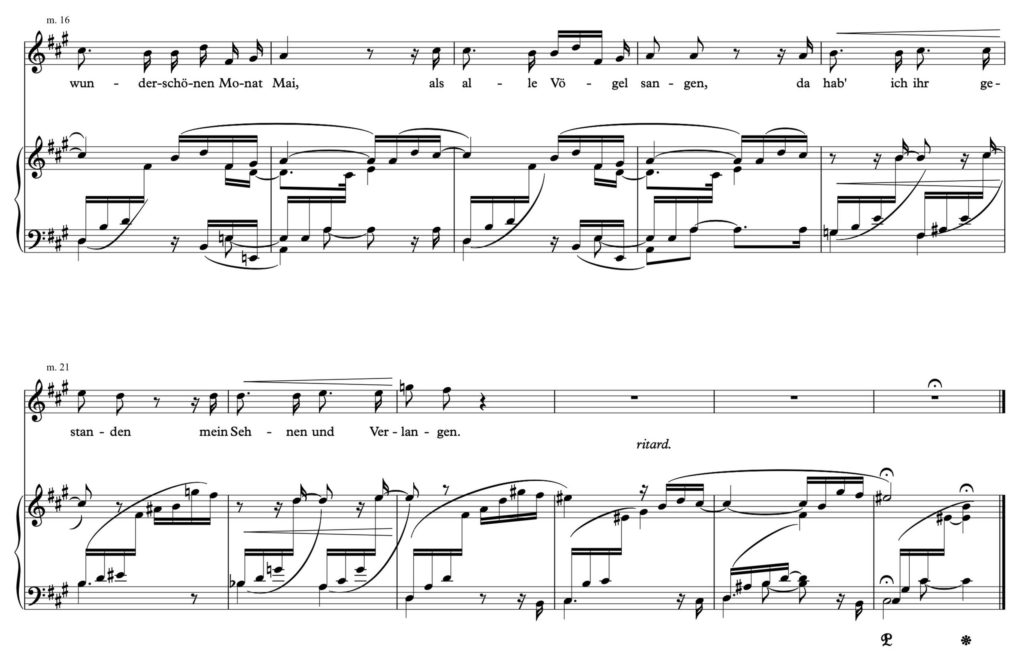
The clarity of each potential allusion suggests varying proximities of memory: Clara’s is clearest, the Mendelssohn is moderately clear, and the Beethoven is most concealed. Oscillating back and forth between them generates motion, directed by the threefold appearances of Clara’s fragment. The centrality of this particular allusion is emphasized as it fills all of the speaker’s silences, preceding, interrupting, and concluding the poetic utterances. Her music occupies the mind fully, directing the thoughts of a speechlessly enraptured individual. When the speaker articulates each stanza, they cycle through an assemblage of musical memories from works that feature content related to various aspects of Heine’s poem, such as romantic separation and rituals of spring.24 Ultimately, these vocal allusions turn back to the impending repetitions of the concerto fragment, always leading to the same place.
Understanding the song as a constellation of intertextual allusions, the following description of the fragment by Beate Julia Perrey (2002) takes on new specificity: “All fragments as they appear in ‘striking combinations’ and ‘surprising turns and configurations’ do also, as an ensemble, ‘reach out ever further beyond themselves’ so as to at least indicate the Absolute. Hence, the fragment is a medium for reflection, a segment of an ensemble whose centre lies outside itself” (31).25 This elevates intertextuality beyond homage and confers structural significance: the allusions gesture away from the song itself, generating directional motion.26 In Perrey’s formulation, the structure of a fragment is like a mobile, a “decorative kinetic structure made of pieces of solid matter which… is set into motion. As we contemplate a mobile, its pieces are suspended within the space it describes through movement, and yet it is we who are setting it in motion, and who decide from which perspective to look” (xi). To revisit a point made many times about this song: the tonal pairing of the song generates substantial “motion” through its ambiguity. Taken in context of Robert’s compositional habits, especially in shorter movements within a cycle, the close on the dominant of F$$\sharp$$ minor is not particularly unusual.27 However, a song constructed almost entirely of intertextual allusions is rather rare, even for a composer that made intertextuality a central feature of his language.28 It is also worth considering that the song’s tonal pairing may have resulted precisely from its prioritization of intertextual juxtapositions.
I do not seek to downplay the significance of the work’s tonal structure, but to link its significance to the intertextual parameter in order to deepen the understanding of the song’s fragmentary status.29 The strength of motion generated by the song’s intertextual gestures resonates with what Perrey describes as the “experience of desire itself”. Fragments open the possibility for a composition to be “no longer about the idea of movement alone” but to be “movement itself—it shapes time” (xiv). Rather than focusing on the theoretical implications of whether such a reading denies the influence of late-nineteenth-century organicism or upholds earlier aesthetics of the fragment, it is possible to consider how both views—contradictory though they may be—can exist together in the song.30 For such a richly multi-layered lied, views of its structure should be correspondingly multi-layered. The song’s distinctive features should be understood to gesture both away from (via allusion) and toward itself (via lack of tonal closure), which may be one reason it has eluded simple analytical explanations. Given the focus on motion generated as a result of intertextual and tonal flux, future interpretations may benefit from considering how the intersection of structure and motion as laid out here could have implications for performance.31
How does the song’s fragmentary structure reflect upon our understanding of what Robert’s allusion to Clara’s concerto might mean? Many possible readings exist. Chief among them, the allusion invokes the biographical dimension. By recalling the most ambitious composition of Clara’s youth and pre-marriage years, Robert gestures to an important stage of the couple’s shared musical history. The allusion evokes femininity more generally, in its citation of a work composed and performed by a woman.32 It draws also upon the concerto itself in order to locate a passage of deeply interiorized reflection within the song’s orbit, blending the contexts of genre in the process. Much more than a one-dimensional romantic gesture, the reference in Dichterliebe demonstrates that in the context of their romantic relationship and temporary physical separation before their marriage, Robert engaged creatively with Clara’s compositional voice. Via allusion, we are drawn toward her concerto. Dichterliebe begins not with Robert’s voice, but with Clara’s.
Conclusion
“Im wunderschönen Monat Mai” stands as a case study for how much more is at play when we carefully investigate the source of an allusion, and in this case, when we allow Clara’s music space to influence our reading of the song. To return to the issue of gender in intertextuality, Klein (49) outlines two stereotypical characterizations of gender dynamics, articulating power relations in sexual terms: either “the poet who borrows is passive,” and “he feminizes himself by allowing another voice to enter him,” or the “feminizing threat is sometimes veiled by a more virile, masculine metaphor: the models of the apprentice writer are territories to be conquered.” The two views are often combined to explain how a composer maintains individuality while drawing upon the works of others, resulting in “analyses…intent on presenting unified, single structures” which “collaborate with meta-narratives that marginalize the feminine characteristics of composing music.” How can we avoid these types of characterizations when we interpret the relationship between Clara’s concerto and Robert’s song? When considering how Clara’s music is referenced by Robert via intertextual allusion, we have not yet made enough room for the idea that her music may exert influence upon a work’s structure beyond the capacity of a one-dimensional romantic gesture. By situating references to her music within broader narratives of autonomy, her voice is marginalized, and the “virile, masculine” characterization of the alluding composer is perpetuated. Such interpretations strive to show how “analysis normalizes strangeness, marginalizes anomaly, and resolves aporia.” Intertextuality offers the analyst another path: by embracing a work “itself” in addition to the others that it references, we start to see how “texts release meaning when surrounded by other texts” (50). Otherwise, critical insight regarding structure and context can be sacrificed. Additionally, the allusion to Clara’s concerto demonstrates how much can be learned from analyzing her music, which is only beginning to be understood on its own terms.33
In 1838, Robert (Schumann 1994, 94) wrote to Clara: “Sometimes it feels as if a great many alleys were running pell-mell through my heart and as if my thoughts and feelings were bustling about in there…just as people do, and they were asking one another, ‘Where does this one lead?’—to Clara—‘and this one?’—to Clara—everything leads to you.” Daverio’s (2002, 139) discussion of this letter ties the impulse of memory and romantic attraction to the ideas of Walter Benjamin: “For Schumann, Clara occupied the ‘enigmatic center’ of a labyrinth that, as Benjamin (1999, 615) observed, arises from the attempt to recall a past life in memory; as the fan of memory unfolds, it greets us with ‘passageways that always, in the most diverse periods of life, guide us to the friend, the betrayer, [and] the beloved”. Perhaps no other song of Robert’s is as well known for its status as an “enigma” as “Im Wunderschönen Monat Mai”. The etymological roots of this word, after the Greek ainissesthai, “to speak allusively”, take on special significance when we pursue the extent to which Clara’s voice resounds in such compositions (Oxford English Dictionary 2000). Robert’s song is an “enigma”—but it is precisely because it “speaks allusively” that we can characterize Clara’s intertextual involvement as the means for an occupation with its “enigmatic center”. Here, Clara’s is the voice of enigma.
References
Benjamin, Walter. 1999. “A Berlin Chronicle.” In Walter Benjamin: Selected Writings, vol. 2: 1927–34, translated by Rodney Livingstone and others, edited by Michael W. Jennings, Howard Eiland, and Gary Smith. Cambridge, MA: Belknap Press of Harvard University Press.
Binder, Benjamin. 2013. “Robert, Clara, and the Transformation of Poetic Irony in Schumann’s Lieder: The Case of ‘Dein Angesicht’”. Nineteenth-Century Music Review 10, no. 1: 1–28.
Borchard, Beatrix. 2019. Clara Schumann. Musik als Lebensform. Hildesheim: Ulms.
Burnham, Scott. 1996. “A. B. Marx and the Gendering of Sonata Form.” In Music Theory in the Age of Romanticism, edited by Ian Bent, 163–86. Cambridge: Cambridge University Press.
Cohn, Richard. 2011. “Tonal Pitch Space and the (Neo-) Riemannian Tonnetz.” In The Oxford Handbook of Neo-Riemannian Music Theories, edited by Edward Gollin and Alexander Rehding, 329–33. New York: Oxford University Press.
Cubero, Diego. 2017. “Inwardness and Inner Melodies in Brahms’s Piano Works.” Music Theory Online 23, no. 1.
Daverio, John. 2002. Crossing Paths: Schubert, Schumann, and Brahms. New York: Oxford University Press.
D’Errico, Lucia. 2020. “One Less Performance of Dichterliebe”. Performance Project at the Orpheus Institute (Ghent, Belgium).
Draper, Hal. 1984. The Complete Poems of Heinrich Heine: A Modern English Version. New York: Oxford University Press.
Dunsby, Jonathan. 2007. “Why Sing? Lieder and Song Cycles.” In The Cambridge Companion to Schumann, edited by Beate Julia Perrey, 102–122. Cambridge: Cambridge University Press.
Ferris, David. 2000. Schumann’s Eichendorff Liederkreis and the Genre of the Romantic Cycle. New York: Oxford University Press.
_________. 2003. “Public Performance and Private Understanding: Clara Wieck’s Concerts in Berlin.” Journal of the American Musicological Society 56, no. 2: 351–408.
Feurzeig, Lisa. 2021. “Romanticism and the Ideal of Song.” In The Cambridge Companion to Music and Romanticism, edited by Benedict Taylor, 277–95. Cambridge: Cambridge University Press.
Hallmark, Rufus. 1979. The Genesis of Schumann’s Dichterliebe: A Source Study. Ann Arbor, MI: UMI Research Press.
Hanslick, Eduard. 1986. On the Musically Beautiful: A Contribution towards the Revision of the Aesthetics of Music. Translated and edited by Geoffrey Payzant. Indianapolis, IN: Hackett Publishing Company.
Hoeckner, Berthold. 1997. “Schumann and Romantic Distance.” Journal of the American Musicological Society 50, no. 1: 55–132.
______________. 2006. “Paths Through Dichterliebe.” 19th-Century Music 30, no. 1: 65–80.
Kallberg, Jeffrey. 1992. “The Harmony of the Tea Table: Gender and Ideology in the Piano Nocturne.” Representations 39: 102–33.
Klassen, Janina. 1990. Clara Wieck-Schumann: Die Virtuosin als Komponistin. Kassel: Bärenreiter.
———. 2020. “Genie oder kein Genie, ist nicht die Frage: Perspektiven auf Clara Wieck Schumanns Kompetenzwerb.” Zeitschrift der Gesellschaft für Musiktheorie 17, no. 1: 103–115.
Klein, Michael L. 2005. Intertextuality in Western Art Music. Bloomington, IN: Indiana University Press.
Koch, Heinrich Christoph. 1802. Musikalisches Lexikon. Frankfurt.
Komar, Arthur, editor. 1971. Schumann: Dichterliebe. New York: W. W. Norton & Company.
Kopp, David. 2011. “Intermediate States of Key in Schumann.” In Rethinking Schumann, edited by Roe-Min Kok and Laura Tunbridge, 303–313. New York: Oxford University Press.
Kramer, Lawrence. 1998. Franz Schubert: Sexuality, Subjectivity, Song. Cambridge: Cambridge University Press.
Krebs, Harald. 2016. “The Influence of Clara Schumann’s Lieder on Declamation in Robert Schumann’s Late Songs.” SMT-V 2.1.
MacDonald, Claudia. 1993. “Critical Perception and the Woman Composer: The Early Reception of Piano Concertos by Clara Wieck Schumann and Amy Beach.” Current Musicology 55: 24–55.
Marston, Nicholas. 1991. “Schumann’s Monument to Beethoven.” 19th-Century Music 14, no. 3: 247–264.
———. 1993. “‘Im Legendton’: Schumann’s ‘Unsung Voice.’” 19th-Century Music 16, no. 3: 227–41.
Martin, Nathan John. 2010. “Schumann’s Fragment.” Indiana Theory Review 28, nos. 1–2: 85–109.
McClary, Susan. 2000. Conventional Wisdom: The Content of Musical Form. Berkeley, CA: University of California Press.
———. 2002. Feminine Endings: Music, Gender, and Sexuality. Minneapolis, MN: University of Minnesota Press.
Neumeyer, David. 1982. “Organic Structure and the Song Cycle: Another Look at Schumann’s Dichterliebe.” Music Theory Spectrum 4: 92–105.
Oxford English Dictionary. 2000. “Enigma.” Oxford University Press.
Pedneault-Deslauriers, Julie. 2016. “Bass-Line Melodies and Form in Four Piano and Chamber Works by Clara-Wieck Schumann.” Music Theory Spectrum 38, no. 2: 133–54.
Perrey, Beate Julia. 2002. Schumann’s Dichterliebe and Early Romantic Poetics: Fragmentation of Desire. Cambridge: Cambridge University Press.
Plantinga, Leon. 1967. Schumann as Critic. New Haven, CT: Yale University Press.
Randel, Don Michael. 2014. “Congruence between Poetry and Music in Schumann’s Dichterliebe.” 19th-Century Music 38 no. 1: 30–52.
Reich, Nancy B. 1985. Clara Schumann: The Artist and the Woman. Ithaca, NY: Cornell University Press.
Reynolds, Christopher Alan. 2003. Motives for Allusion: Context and Content in Nineteenth Century Music. Cambridge, MA: Harvard University Press.
Ronyak, Jennifer. 2018. Intimacy, Performance, and the Lied in the Early Nineteenth Century. Bloomington, IN: Indiana University Press.
Rosen, Charles. 1995. The Romantic Generation. Cambridge, MA: Harvard University Press.
———. 1988. Sonata Forms: Revised Edition. New York: W. W. Norton & Company.
Schenker, Heinrich. 1935. Der Freie Satz. Vienna: Universal Edition.
Schlegel, Friedrich. 1958. Kritische Friedrich-Schegel-Ausgabe in 35 Bänden. Edited by Ernst Behler et al., vol 3. Paderborn: Schöningh.
Schmalfeldt, Janet. 2011. In the Process of Becoming: Analytic and Philosophical Perspectives on Form in Early Nineteenth-Century Music. New York: Oxford University Press.
———. 2020. “From Literary Fiction to Music: Schumann and the Unreliable Narrative.” 19th-Century Music 43, no. 3: 170–193.
Schumann, Clara and Robert. (1837) 1984. Briefwechsel. Kritische Gesamtausgabe. Vol. 1, 1832–38. Edited by Eva Weissweiler. Frankfurt am Main: Sternfeld/Roter Stern.
———. 1994. The Complete Correspondence of Robert and Clara Schumann, Critical Edition, vol. 1. Edited by Eva Weissweiler, translated by Hildegard Fritsch and Ronald L. Crawford. New York: Peter Lang.
Schumann, Robert. 1835. “Schwärmbriefe.” Neue Zeitschrift für Musik 3(46): 182.
———. 1942. Robert Schumann in seinem Schriften und Briefen. Edited by Wolfgang Boetticher. Berlin: Hahnefeld.
Stefaniak, Alexander. 2016. Schumann’s Virtuosity: Criticism, Composition, and Performance in Nineteenth-Century Germany. Bloomington, IN: Indiana University Press.
———. 2017. “Clara Schumann’s Interiorities and the Cutting Edge of Popular Pianism.” Journal of the American Musicological Society 70, no. 3: 697–765.
———. 2018. “Clara Schumann and the Imagined Revelation of Musical Works.” Music & Letters 99, no. 2: 194–223.
Taylor, Benedict. 2011. Mendelssohn, Time and Memory: The Romantic Conception of Cyclic Form. Cambridge: Cambridge University Press.
———. 2015. The Melody of Time: Music and Temporality in the Romantic Era. New York: Oxford University Press.
———. 2021. “‘Du meine Seele, du mein Herz’: Self, Other, and Hemaphroditic Union in the Music of Robert (and Clara) Schumann”. Zeitschrift der Gesellschaft für Musiktheorie 18, no. 2.
———. 2022. Music, Subjectivity, and Schumann. Cambridge: Cambridge University Press.
Taylor, Charles. 1989. Sources of the Self: The Making of the Modern Identity. Cambridge, MA: Harvard University Press.
Todd, R. Larry. 1994. “On Quotation in Schumann’s Music.” In Schumann and His World, edited by R. Larry Todd, 80–112. Princeton, NJ: Princeton University Press.
———. 2002. “‘Ein wenig still und scheu’ – Clara Wieck-Schumann as Colleague of Felix Mendelssohn Bartholdy.” In Schumanniana Nova: Festschrift Gerd Nauhaus zum 60. Geburtstag, edited by Bernhard R. Appel, Ute Bär, and Matthias Wendt, 767–784. Sinzig: Studio Verlag.
Turchin, Barbara. 1981. Robert Schumann’s Song Cycles in the Context of the Early Nineteenth Century Liederkreis. Ph.D. diss., Columbia University.
Vande Moortele, Steven. 2017. The Romantic Overture and Musical Form from Rossini to Wagner. Cambridge: Cambridge University Press.
———. 2021. “Romantic Forms”. In The Cambridge Companion to Music and Romanticism. Edited by Benedict Taylor, 258–276. Cambridge: Cambridge University Press.
Watkins, Holly. 2011. Metaphors of Depth in German Musical Thought: from E. T. A Hoffmann to Arnold Schoenberg. Cambridge: Cambridge University Press.
———. 2012. “The Floral Poetics of Schumann’s Blumenstück, Op. 19.” 19th-Century Music 36, no. 1: 24–45.
Weaver, Andrew H. 2017. “Memories Spoken and Unspoken: Hearing the Narrative Voice in Dichterliebe.” Journal of the Royal Musical Association 142, no. 1: 31–67.
Weinstein-Reiman, Michael. 2017. “‘Inside’ Voices and Coupling Dynamics: An Analysis of Clara Wieck-Schumann’s Notturno from Soirées Musicales, Op. 6 No. 2.” Theory and Practice 42: 1–28.
Wozonig, Thomas. 2020. “Gender, Schaffensprozess und musikalische Analyse: Clara Schumanns Drei gemischte Chöre (1848).” Zeitschrift der Gesellschaft für Musiktheorie 17, no. 1: 117–145.
Notes
- The vast analytical literature on Dichterliebe features a multitude of readings that result from contrasting methodological frames; only a cross-section is referenced here. A tradition of voice-leading analysis originating in Schenker (1935) extends through Komar (1971) and Neumeyer (1982), which are critiqued by Ferris (2000, 26-58). Rosen (1995), Ferris (2000), and Perrey (2002) shift away from concerns with organicism toward perspectives centered upon the Romantic fragment. In response, Hoeckner (2006) offers another view considering both the whole and the fragment. Cohn (2011) considers the song through the viewpoint of a Neo-Riemannian Tonnetz while Kopp (2011) focuses on how it might shed light on the concept of key. Other analysts have recently focused on text and music relationships, such as Randel (2014)’s focus on sound in poetry and music, and the concept of narrative as it applies to Dichterliebe, particularly in Weaver (2017) and Schmalfeldt (2020). Most often, these studies do not view Robert’s cycle in relation to Clara’s compositions.
- Power dynamics are considered in the intertextuality of Robert and Clara by Kallberg (1992) and Reiman-Weinstein (2017). Both comment on the allusion in Robert’s eighth Novellette, op. 21, to Clara’s Notturno, op. 6, no. 2. Kallberg discusses the “generalized feminine spirit” (122) of the Nocturne as a genre, marked in contrast to others such as the concerto. Reiman-Weinstein calls the Novellette’s allusion an “arrogation” (25).
- On the concerto’s origins, see Reich (1985, 239-40), Klassen (1990), and MacDonald (1993).
- On the aesthetics associated with flowers in Robert’s criticism and music, as well as in Heine’s poetry, see Watkins (2012).
- In correspondence from November 1837, Robert reiterated that the concerto’s ideas were at times “stellar” but that the work “did not make a complete impression” ([1837] 1984, 53 translated by MacDonald 1993, 27). Wieck responded in defense of the work’s continued performance while on tour, as it certainly pleased audiences, but she agreed that the work had its faults. Her final thought on the concerto’s imperfections is intriguing: “I know [them] precisely, but the audience does not, and furthermore does not need to know” ([1837] 1984, 53, translated by MacDonald, 27).
- Robert’s own Piano Concerto, completed in 1845, bears similar traits. For example, its first movement in A minor also features a lengthy tonicization of A-flat major. Though Clara’s composition was criticized for this distant modulation (see MacDonald, 31), Robert’s concerto was seen as novel. Stefaniak (2016, 182) discusses further Robert’s mid-career shift of style and aesthetic, with its approach to Clara’s works reflecting a “complex mix of emulation, reinterpretation, and critique” (176), building on observations made by Hoeckner (1997, 130).
- Other precedents include Schubert’s Wanderer Fantasy, D. 760 (1822), and Moscheles, Piano Concerto No. 6, “Concert Fantastique”, op. 90 (1834, published in 1836).
- For another study addressing romantic cyclical form and its relationship to temporality, see Taylor (2011, 2015). Stefaniak (2017) locates interiority in Clara’s performances not as the “tender quality one might describe as ‘innig’” but instead in conceptions of where virtuosic displays were “issued from, how they resonated with the listener, and how they related to other elements in a composition” (701). This vantage point involves the intersubjective merging of performer and composer central to nineteenth-century musical aesthetics.
- Marston (1993, 227-41) recounts and translates the definition of “Romanze” from Koch (1802, col. 1271): the vocal Romanze’s poetic content centered on “tragic” or “amorous” topics in a “lyric verse form.” Fashioned into simple melodic utterances, initially these expressions shaped a musical form that had no intrinsic design of its own, mirroring the unique unfolding of the accompanying text. Eventually, the Romanze’s text-driven musical structures most often took the shape of ternary forms. Koch also identifies an instrumental variant characterized by similar expressive content, a slow tempo, and rondo form. Marston argues that Koch’s “instrumental variant” definition matches the “Romanza/Im Legendton” interpolation in the first movement of Robert’s Fantasy, op. 17. Hoeckner (1997, 121-123) suggests that this movement is modeled on Clara’s Romance varieé, op. 3. The genre of the Romance would be revisited by Clara a total of fourteen times in her output.
- Taylor (2021) examines duets – and their portrayals of “self, other, and hermaphroditic union” – in music by Robert and Clara.
- Interpretations of Robert’s song frequently dwell on the sense of anticipation fostered especially by its tonal pairing of F$$\sharp$$ minor and A major. For example, Perrey observes: “anticipation is the general gesture by which Song 1 is characterized” (171).
- For this reason, the Romanze can be seen to take on a distinctly operatic character, as if two characters are sharing a melody in an aria. Ronyak (2018, 148-171) cites an unusual instrumental duet in Romberg’s setting of Schiller’s “Sehnsucht” as an expression of intimacy in a public genre, as this particular hybrid “Gesangstück” mixes elements of Lied, aria, and cantata. A moment of instrumental prominence is characterized as a “Lied within a Lied” (158). Also, see Ferris (2003) on public and private dimensions of Clara’s music-making.
- It is also important to acknowledge that, although Robert is recalling a passage from a piano concerto—a public genre—he is drawing upon an extraordinarily intimate movement.
- On related issues of register in piano music and the expression of inner-voice melodies in works of Brahms, see Cubero (2017).
- Martin (2010) designates the song’s use of sentence phrase structure as a special combination of continuation and cadential function in the piano solos. The author traces how Schumann blends traits of Classical phrase structure in order to create a song that coheres as a self-standing fragment.
- Certainly this is not the only potential intertextual influence that contextualizes the tonal pairing. Rosen (1988, 380) observes another “anomalous” tonal pairing between F# minor and A major in the finale of Schumann’s Piano Sonata in F# minor, Op. 11, and Neumeyer (98-102) considers the archaic pastness invoked by the Baroque Phrygian half cadence. Also see Marston (1991) for the cycle’s debt to Beethoven. On the other hand, distinguished analysts have opined that Dichterliebe is largely devoid of intertextuality, interpreting the cycle as excluding “‘Clara’ themes or Beethoven quotations” (Dunsby 2007, 107).
- Another of Robert’s allusions to Clara’s music repeat also repeats a fragment three times, although the narrative of union in the end is supported by evolving tonal contexts. In the Novelette, op. 21, no. 8, the “voice from afar” which alludes to a passage from Clara’s “Notturno,” op. 6, no. 2, sounds twice in D major, and in its third appearance, the F major tonality of its original context is restored. The transposition is often viewed as a means of relational engagement (by Rosen (1995, 660), Hoeckner (1997, 126–31), and Todd (1994, 102)), suggesting that Clara is brought into contact in musical terms. This is starkly different from the opening of Dichterliebe, which makes a point of fixing the recurring fragment’s musical structure, resulting in the song’s memorable open ending.
- Turchin (1981, 288–90) suggests the entire song cycle could be a memory of past events.
- Ferris (2000) cautions against viewing Robert’s selections as support for an interpretation of narrative. Hoeckner (2006) and Weaver (2017) suggest that both interpretations of fragment and narrative can be sustained simultaneously in the cycle.
- Hallmark (1979, 36) relates the past tense of the first song of Dichterliebe and its nostalgia to Heine’s Prologue. Daverio (2002, 61) describes more generally how pastness is evoked via allusion in Robert’s music, especially by “mémoire involuntaire”, as he alludes to compositions by Clara. This is also discussed by Hoeckner (1997).
- The song’s temporal orientation has been described as directing toward the past by other analysts: Rosen (51) claims “the opening song of Dichterliebe is a closed, circular form in which beginning and ending are unstable—implying a past before the song begins and a future after its final chord,” and Perrey (177) states “the very existence of Song 1 presupposes an artistic matrix prior to its own existence, and out of which it has arisen.”
- Perrey interprets Heine’s poem as an allusion to Solomon’s Hohelied in the Lutheran Bible (96) and Reynolds interprets it as an allusion to Raßmann’s 1821 poem which shares its opening line (70).
- Reynolds consults early sketches of the song and their clearer melodic resemblances to the Beethoven passage.
- The cited passage from Fidelio features dramatic irony: while Leonore is disguised as Fidelio and is accompanied by Rocco to visit Florestan during his imprisonment, they sing together in “Euch werde Lohn in bessern Welten”, unbeknownst to Florestan. This pivotal moment plays on absence and presence. The passage from Die erste Walpurgisnacht centers on pagan rituals of spring.
- Perrey’s internal citation is to Schlegel (1958). The original German is included here: “Merkwürdige Kombinationen… überraschende Wendungen und Konfigurationen… die stets über sich selbst hinausweisen” (51).
- See Klein’s chapter on “The Appeal to Structure”, which concisely states: “A musical structure is a relational event among texts. A musical structure is an intertextuality” (31).
- Robert employs numerous strategies to end “off-tonic”. A few representative examples from the Lieder include “Auf einer Burg”, op. 39, no. 7, “Anfangs woll ich fast verzagen”, op. 24, no. 8, and “Stirb, Lieb und Freud!” op. 35, no. 2, which all can be read as ending on the dominant. “Nun hast du mir den ersten Schmerz getan” op. 42, no. 8 concludes Frauenliebe und -leben, and while it returns to the cycle’s opening B$$\flat$$ major, it contradicts the song’s opening in D minor. In the piano works, Kinderszenen, op. 15 sets up the sense of improvisatory freedom at the start of “Der Dichter spricht” by concluding “Kind im Einschlummern” on the subdominant. Space prohibits a full account of Robert’s open endings, which are found in a variety of generic contexts. In Clara’s works, “Die stille Lotosblume”, op. 13, no. 6, opens and closes on the dominant.
- Perhaps Robert has, with this constellation of fragmentary allusions by numerous different authors, drawn a musical response to Schlegel’s early collections of literary fragments. As Feurzeig (2021) recounts: “Schlegel pioneered a genre he called the fragment. He wrote many of these pithy comments, and also recruited his friends as contributors, publishing fragments in sets without revealing who had written which ones (though later editors have worked out attributions). This mix of materials, ideas, and authors was meant to symbolise the interconnectedness of the universe… [Schlegel] also made a point of grouping fragments, creating a clear sense of relationship amongst them” (279–280). Robert’s song similarly draws together numerous authors to form a musical fragment.
- For Vande Moortele (2021), the song’s formal status as a fragment motivates the view that its “openness more obviously serves to connect the individual song to the cycle as a whole” (269). If the song itself constitutes a fragment within the cycle, its intertextual allusions splinter off further into local fragments within itself.
- As stated above, this is a conceptual point of resonance with Hoeckner (2006) and Weaver (2017).
- A provocative take on performance issues in Dichterliebe may be found in Lucia D’Errico’s work conducted at the Orpheus Institute (Ghent, Belgium): “One Less Performance of Dichterliebe”, https://orpheusinstituut.be/en/projects/one-less-performance-of-dichterliebe, accessed August 18, 2022.
- 2Along with Klein, significant studies on gender in music includes Burnham (1996), Kramer (1998), McClary (2000, 2002), and Vande Moortele (2017). Of special interest to the present study, Kramer and McClary especially draw together the concepts of gender and interiority.
- Following the groundbreaking work of Reich (1985) and Klassen (1990), recent studies such as Pedneault-Deslauriers (2016), Stefaniak (2017), Weinstein-Reiman (2017), Stefaniak (2018), Borchard (2019), Klassen (2020), and Wozonig (2020) have laid a foundation for future analytical interpretations of Clara Schumann’s works. Clara’s influence on Robert, whether through music or correspondence, is addressed by Hoeckner (1997), Binder (2013), Krebs (2016), and Taylor (2021).
